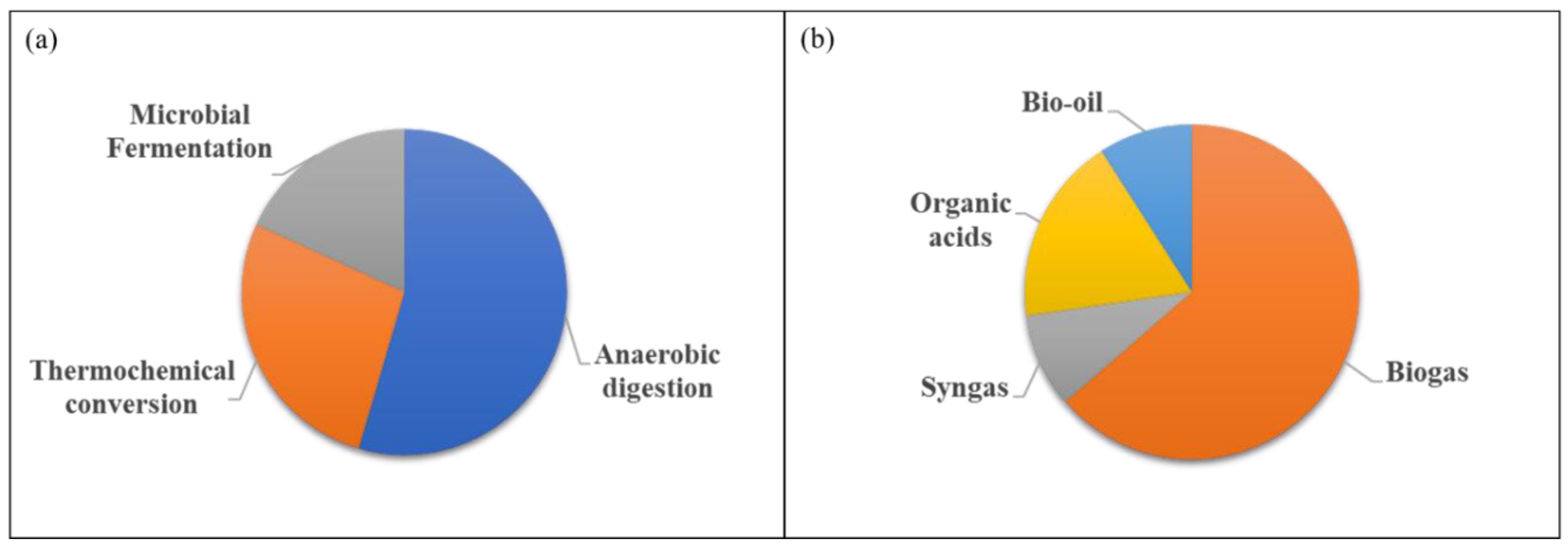Processes for Bioenergy and Resources Recovery from Biowaste
1. Introduction
2. Statistics of the Special Issue
- China (7)
- Canada (2)
- USA (1)
- Indonesia (1)
- Sweden (1)
3. Overview of the Contributions
Funding
Acknowledgments
Conflicts of Interest
References
- Pan, C.; Bolingbroke, D.; Ng, K.T.W.; Richter, A.; Vu, H.L. The use of waste diversion indices on the analysis of Canadian waste management models. J. Mater. Cycles Waste Manag. 2019. [Google Scholar] [CrossRef]
- Lee, U.; Han, J.; Wang, M. Evaluation of landfill gas emissions from municipal solid waste landfills for the life-cycle analysis of waste-to-energy pathways. J. Clean. Prod. 2017. [Google Scholar] [CrossRef]
- Lansing, S.; Hülsemann, B.; Choudhury, A.; Schueler, J.; Lisboa, M.S.; Oechsner, H. Food waste co-digestion in Germany and the United States: From lab to full-scale systems. Resour. Conserv. Recycl. 2019. [Google Scholar] [CrossRef]
- Zhou, M.; Yan, B.; Wong, J.W.C.; Zhang, Y. Enhanced volatile fatty acids production from anaerobic fermentation of food waste: A mini-review focusing on acidogenic metabolic pathways. Bioresour. Technol. 2018. [Google Scholar] [CrossRef] [PubMed]
- Demetrious, A.; Crossin, E. Life cycle assessment of paper and plastic packaging waste in landfill, incineration, and gasification-pyrolysis. J. Mater. Cycles Waste Manag. 2019, 21, 850–860. [Google Scholar] [CrossRef]
- Chai, Y.; Gao, N.; Wang, M.; Wu, C. H2 production from co-pyrolysis/gasification of waste plastics and biomass under novel catalyst Ni-CaO-C. Chem. Eng. J. 2020. [Google Scholar] [CrossRef]
- Barua, S.; Dhar, B.R.B.R. Advances towards understanding and engineering direct interspecies electron transfer in anaerobic digestion. Bioresour. Technol. 2017, 244. [Google Scholar] [CrossRef]
- Barber, W.P.F. Thermal hydrolysis for sewage treatment: A critical review. Water Res. 2016. [Google Scholar] [CrossRef]
- Zakaria, B.S.; Dhar, B.R. Progress towards catalyzing electro-methanogenesis in anaerobic digestion process: Fundamentals, process optimization, design and scale-up considerations. Bioresour. Technol. 2019. [Google Scholar] [CrossRef]
- Barua, S.; Zakaria, B.S.; Chung, T.; Hai, F.I.; Haile, T.; Al-Mamun, A.; Dhar, B.R. Microbial electrolysis followed by chemical precipitation for effective nutrients recovery from digested sludge centrate in WWTPs. Chem. Eng. J. 2019. [Google Scholar] [CrossRef]
- Akbari, M.; Oyedun, A.O.; Kumar, A. Techno-economic assessment of wet and dry torrefaction of biomass feedstock. Energy 2020. [Google Scholar] [CrossRef]
- Sansaniwal, S.K.; Rosen, M.A.; Tyagi, S.K. Global challenges in the sustainable development of biomass gasification: An overview. Renew. Sustain. Energy Rev. 2017. [Google Scholar] [CrossRef]
- Chowdhury, B.; Magsi, S.B.; Ting, H.N.J.; Dhar, B.R. High-solids anaerobic digestion followed by ultrasonication of digestate and wet-type anaerobic digestion for enhancing methane yield from OFMSW. Processes 2020, 8, 555. [Google Scholar] [CrossRef]
- Wu, B.; Xi, B.; He, X.; Sun, X.; Li, Q.; Ouche, Q.; Zhang, H.; Xue, C. Methane emission reduction enhanced by hydrophobic biochar-modified soil cover. Processes 2020, 8, 162. [Google Scholar] [CrossRef] [Green Version]
- Pang, E.; Liu, W.; Zhang, S.; Fu, N.; Tian, Z. Characteristics of low-temperature polyvinyl chloride carbonization by catalytic CuAl layered double hydroxide. Processes 2020, 8, 120. [Google Scholar] [CrossRef] [Green Version]
- Gu, Q.; Wu, W.; Jin, B.; Zhou, Z. Analyses for synthesis gas from municipal solid waste gasification under medium temperatures. Processes 2020, 8, 84. [Google Scholar] [CrossRef] [Green Version]
- Supramono, D.; Sitorus, A.F.; Nasikin, M. Synergistic effect on the non-oxygenated fraction of bio-oil in thermal co-pyrolysis of biomass and polypropylene at low heating rate. Processes 2020, 8, 57. [Google Scholar] [CrossRef] [Green Version]
- Wang, S.; Dong, H.; Geng, Z.; Dong, X. CFD study of gas holdup and frictional pressure drop of vertical riser inside IC reactor. Processes 2019, 7, 936. [Google Scholar] [CrossRef] [Green Version]
- Dong, X.; Wang, S.; Geng, Z. CFD simulation on hydrodynamic behaviors of anaerobic granule swarms. Processes 2019, 7, 880. [Google Scholar] [CrossRef] [Green Version]
- Kakar, F.L.; Koupaie, E.H.; Hafez, H.; Elbeshbishy, E. Effect of hydrothermal pretreatment on volatile fatty acids production from source-separated organics. Processes 2019, 7, 576. [Google Scholar] [CrossRef] [Green Version]
- Yu, J.; Liao, J.; Huang, Z.; Wu, P.; Zhao, M.; Liu, C.; Ruan, W. Enhanced anaerobic mixed culture fermentation with anion-exchange resin for caproate production. Processes 2019, 7, 404. [Google Scholar] [CrossRef] [Green Version]
- Liu, Y.; Kang, X.; Cheng, H. Enhanced anaerobic performances of kitchen wastes in a semi-continuous reactor by EDTA improving the water-soluble fraction of Fe. Processes 2019, 7, 351. [Google Scholar] [CrossRef] [Green Version]
- Pererva, Y.; Miler, C.D.; Sims, R.C. Sulfur, Phosphorus and Metals in the Stoichiometric Estimation of Biomethane and Biohydrogen Yields. Processes 2020, 8, 714. [Google Scholar] [CrossRef]
- Anukam, A.; Mohammadi, A.; Naqvi, M.; Granström, K. A Review of the Chemistry of Anaerobic Digestion: Methods of Accelerating and Optimizing Process Efficiency. Processes 2019, 7, 504. [Google Scholar] [CrossRef] [Green Version]

© 2020 by the authors. Licensee MDPI, Basel, Switzerland. This article is an open access article distributed under the terms and conditions of the Creative Commons Attribution (CC BY) license (http://creativecommons.org/licenses/by/4.0/).
Share and Cite
Elbeshbishy, E.; Dhar, B.R. Processes for Bioenergy and Resources Recovery from Biowaste. Processes 2020, 8, 1005. https://doi.org/10.3390/pr8081005
Elbeshbishy E, Dhar BR. Processes for Bioenergy and Resources Recovery from Biowaste. Processes. 2020; 8(8):1005. https://doi.org/10.3390/pr8081005
Chicago/Turabian StyleElbeshbishy, Elsayed, and Bipro Ranjan Dhar. 2020. "Processes for Bioenergy and Resources Recovery from Biowaste" Processes 8, no. 8: 1005. https://doi.org/10.3390/pr8081005



